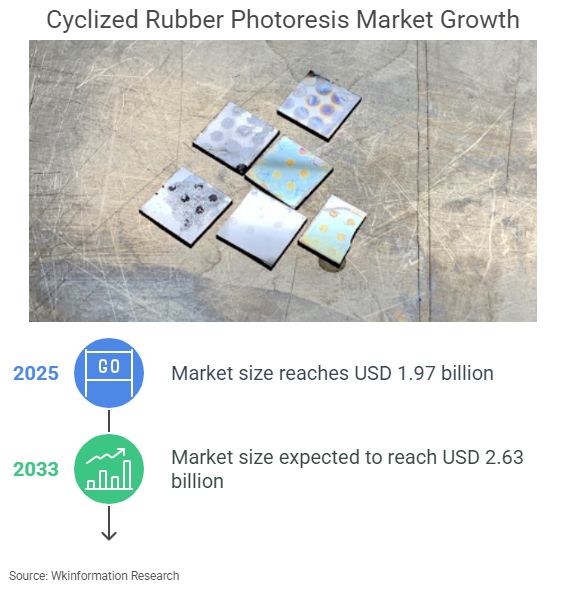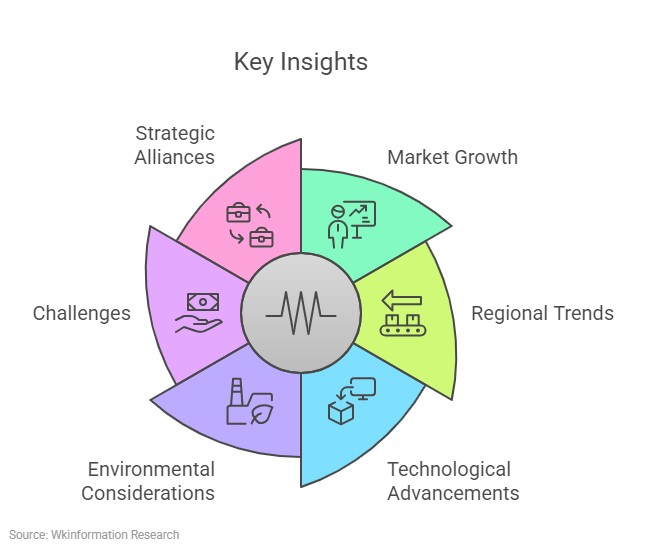
Cyclized rubber photoresist plays a pivotal role in photolithography, a process essential for creating intricate patterns on electronic components. Known for its high chemical resistance and superior adhesion, this material ensures precision and durability in manufacturing. Its application in the electronics and semiconductor industries is indispensable due to its ability to deliver excellent resolution and etch resistance. These qualities make it a preferred choice for advanced technologies like EUV lithography. The market size will reach USD 1.97 billion in 2025 and is expected to reach USD 2.63 billion by 2033, with a CAGR of 3.68% from 2025 to 2033. As the demand for high-performance semiconductors grows, the cyclized rubber photoresis market continues to expand, driven by the need for innovative materials in high-tech manufacturing.
Key Insights
- The cyclized rubber photoresist market may reach $1.97 billion by 2025. It is growing at about 3.68% each year. This is due to more need for better materials in electronics.
- Developing countries are using new manufacturing methods quickly. This increases the need for cyclized rubber photoresists, especially in Asia-Pacific.
- New technology, like EUV lithography, makes these materials work better. Companies are also creating eco-friendly products to meet global green goals.
- High costs and strict rules make things harder for this market. Companies need to create new ideas and use green methods to stay ahead.
- Teaming up and spending on research is very important. This helps companies grow in new markets and make better products.

Market Overview

Current Market Size and Growth Rate
The cyclized rubber photoresist market has shown remarkable growth in recent years. It is projected to reach approximately USD 1.97 billion by 2025, with a compound annual growth rate (CAGR) of around 3.68% from 2025 to 2033. This growth reflects the increasing demand for high-performance materials in advanced manufacturing processes. The market outlook remains positive, driven by the rapid expansion of the electronics and semiconductor industries.
Key Market Trends
Rising Demand in Semiconductor Manufacturing
The semiconductor industry continues to drive the cyclized rubber photoresist market. The miniaturization of devices has created a need for materials capable of supporting complex circuitry and fine feature sizes. Cyclized rubber photoresists, with their excellent resolution and etch resistance, meet these requirements effectively. The rise of smart devices, IoT technology, and 5G networks further amplifies this demand.
Increasing Adoption in Emerging Economies
Emerging economies are adopting advanced manufacturing techniques at an accelerated pace. Investments in digital transformation and microelectronics production have surged in regions like Asia-Pacific. This trend has significantly contributed to the market outlook, as these economies prioritize the development of high-tech industries.
Technological Advancements in Photoresist Materials
Technological innovations are reshaping the cyclized rubber photoresist market. The development of next-generation photoresist products, driven by extreme ultraviolet (EUV) lithography, has enhanced the performance of these materials. Additionally, the focus on eco-friendly and sustainable solutions aligns with global environmental goals. Digital technologies, including AI and automation, also influence advancements in this sector.
Market Drivers and Restraints
Drivers: Growing Electronics Industry, Miniaturization of Devices
The growing electronics industry plays a pivotal role in driving the cyclized rubber photoresis market. The miniaturization of devices has increased the demand for high-performance photoresists, essential for creating intricate patterns on electronic components. These materials enable the production of advanced semiconductor devices required for applications such as AI, machine learning, and 5G technology.
Restraints: High Production Costs, Environmental Concerns
Despite its growth, the cyclized rubber photoresist market faces challenges. High production costs and the initial investment required for development hinder market expansion. Environmental concerns also pose significant restraints. Compliance with stringent regulations regarding chemical usage in manufacturing processes remains a critical issue for industry players.
Key Players in the Cyclized Rubber Photoresis Market
Major Companies in the Market
Tokyo Ohka Kogyo Co., Ltd.: Market Share and Innovations
Tokyo Ohka Kogyo Co., Ltd. (TOK) holds a significant position in the cyclized rubber photoresist market. The company is renowned for its innovative product portfolio, which includes advanced photoresist materials tailored for extreme ultraviolet (EUV) lithography. TOK has consistently invested in research and development to enhance product performance and meet the evolving demands of semiconductor manufacturing. Its commitment to sustainability is evident through the adoption of eco-friendly manufacturing practices, such as the use of recyclable materials and low-toxicity solvents.
JSR Corporation: Strategic Developments
JSR Corporation has emerged as a leader in the cyclized rubber photoresist market due to its strategic focus on product innovation and market expansion. The company has developed cutting-edge photoresist solutions that cater to the miniaturization needs of modern electronics. JSR’s partnerships with global semiconductor manufacturers have strengthened its market presence. Additionally, the company emphasizes customer satisfaction by offering tailored solutions and exceptional service quality.
DuPont: Regional Influence
DuPont leverages its extensive global network to maintain a strong regional influence in the cyclized rubber photoresist market. The company has introduced high-performance photoresist materials designed for diverse applications, including printed circuit boards and optical devices. DuPont’s sustainability initiatives, such as the implementation of recycling programs and the use of eco-friendly solvents, align with industry trends. These efforts have bolstered its reputation as a forward-thinking market player.
Emerging Players and Startups
Focus on Innovation and Niche Applications
Emerging players and startups are reshaping the competitive landscape of the cyclized rubber photoresist market. These companies often focus on niche applications, such as flexible electronics and advanced optical devices, to differentiate themselves. For instance, smaller regional competitors are developing specialized photoresist materials to cater to the unique requirements of local markets. This approach allows them to carve out a distinct space in the industry while addressing specific customer needs. The emphasis on innovation and adaptability positions these players as key contributors to the market’s growth.
Note: The cyclized rubber photoresist market benefits from a mix of established leaders and agile newcomers. This dynamic fosters healthy competition and drives continuous advancements in product quality and sustainability.
Market Segmentation
By Product Type
Positive Photoresists
Positive photoresists dominate the cyclized rubber photoresis market due to their ability to deliver high-resolution patterns. These materials dissolve in exposed areas during photolithography, enabling precise circuit designs. Their application is critical in semiconductor manufacturing, where intricate patterns are essential for advanced microchips. Positive photoresists also support the miniaturization of electronic devices, a key trend in the industry.
Negative Photoresists
Negative photoresists, while less common, play a vital role in specific applications. These materials harden in exposed areas, making them suitable for creating robust patterns on printed circuit boards (PCBs). Their durability and resistance to harsh chemicals make them ideal for environments requiring long-lasting performance. Negative photoresists also find use in optical devices, where structural integrity is paramount.
By Application
Semiconductor Manufacturing
Cyclized rubber photoresists are indispensable in semiconductor fabrication. They enable the production of high-performance microchips required for devices like smartphones, laptops, and IoT systems. The growing demand for advanced electronic devices and the expansion of the semiconductor industry drive this segment’s growth.
Printed Circuit Boards (PCBs)
PCBs rely on cyclized rubber photoresists for precise patterning and etching. These materials ensure the reliability and efficiency of electronic circuits, which are critical for various consumer and industrial applications. The increasing adoption of smart technologies further boosts demand in this segment.
Optical Devices and Displays
Optical devices and display panels benefit from the unique properties of cyclized rubber photoresists. These materials enhance the clarity and durability of components, making them essential for high-quality displays and advanced optical systems.
- Primary applications of cyclized rubber photoresists include:
- Semiconductor fabrication
- Printed circuit board manufacturing
- Other electronic components
These applications drive market demand by facilitating the production of advanced electronic devices, which are increasingly necessary across various industries.
By Region
North America
North America holds a significant share of the cyclized rubber photoresis market. The region’s robust semiconductor industry and demand for high-performance materials contribute to its steady growth rate of 5%.
Europe
Europe demonstrates moderate growth, driven by eco-friendly solutions and bio-based photoresists. The region’s focus on sustainability aligns with global environmental goals, supporting its market outlook.
Asia-Pacific
Asia-Pacific leads the market with the highest growth rate. The region’s dominance stems from its role as a major hub for electronics and semiconductor manufacturing. Countries like China, Japan, and South Korea drive demand through substantial investments in high-tech industries.
Rest of the World
The rest of the world shows potential for growth, particularly in emerging markets. Investments in digital infrastructure and electronics manufacturing create opportunities for cyclized rubber photoresists in these regions.
Competitive Landscape
Market Competition Analysis
Strategies of Leading Companies
Leading companies in the cyclized rubber photoresist market employ diverse strategies to maintain their competitive edge. Tokyo Ohka Kogyo Co., Ltd. focuses on innovation by developing advanced photoresist materials tailored for extreme ultraviolet (EUV) lithography. JSR Corporation strengthens its market position through strategic partnerships with global semiconductor manufacturers, ensuring access to cutting-edge technologies. DuPont leverages its extensive global network to expand its regional influence, introducing high-performance photoresists for various applications. These strategies enable these companies to address the evolving demands of the semiconductor and electronics industries effectively.
Mergers, Acquisitions, and Partnerships
Mergers, acquisitions, and partnerships play a pivotal role in shaping the competitive landscape. Companies collaborate to pool resources, enhance R&D capabilities, and expand their market presence. For instance, partnerships between established players and emerging startups foster innovation by combining expertise in niche applications with large-scale manufacturing capabilities. These collaborations also facilitate the development of eco-friendly solutions, aligning with global sustainability goals.
Innovations and R&D Investments
Focus on Sustainable and Eco-Friendly Solutions
The cyclized rubber photoresist market increasingly emphasizes sustainability. Companies adopt eco-friendly manufacturing practices to meet regulatory requirements and consumer expectations. Key initiatives include:
- Implementing recycling programs for waste materials.
- Utilizing eco-friendly solvents to reduce environmental impact.
- Prioritizing bio-based photoresists, particularly in Europe, where sustainability drives market trends.
These efforts reflect the industry’s commitment to reducing its ecological footprint while maintaining high product performance.
Development of High-Performance Photoresists
R&D investments drive the development of high-performance photoresists. In North America, companies like Dow Chemical and DuPont focus on enhancing product performance to meet the demands of advanced semiconductor manufacturing. The Asia-Pacific region, led by China and Japan, invests heavily in R&D to support the growing consumer electronics market. These innovations improve resolution, durability, and efficiency, ensuring that cyclized rubber photoresists remain integral to high-tech manufacturing processes. This dynamic market outlook highlights the importance of continuous improvement and strategic investment.
Future Projections for the Cyclized Rubber Photoresis Market

Anticipated Market Growth
Forecasted CAGR and Market Value
The cyclized rubber photoresist market is expected to experience robust growth in the coming years. Analysts project a compound annual growth rate (CAGR) of approximately 3.68% from 2025 to 2033. This steady growth reflects the increasing demand for high-performance materials in advanced manufacturing processes.
Emerging Opportunities in Developing Regions
Developing regions present immense opportunities for the cyclized rubber photoresist market. Rapid industrialization and urbanization in Asia-Pacific, particularly in countries like China and India, drive demand for advanced materials. Similarly, Latin America and the Middle East & Africa are experiencing economic growth and industrial expansion. These regions offer untapped potential for market players, especially as governments invest in digital infrastructure and high-tech industries.
Challenges and Risks
Regulatory and Environmental Challenges
The cyclized rubber photoresist market faces significant regulatory hurdles. Strict environmental regulations regarding chemical usage in manufacturing processes pose challenges for industry players. Governments and industry organizations enforce stringent standards to ensure chemical safety and minimize environmental impact. These regulations often require companies to adopt eco-friendly practices, which can increase production costs and complicate compliance.
Supply Chain Disruptions and Raw Material Costs
Supply chain disruptions and fluctuating raw material prices represent additional risks to the market. Shortages of critical components can delay production and increase costs, affecting the availability of cyclized rubber photoresist solutions. For instance, disruptions in the supply of key chemicals or materials can hinder manufacturing processes. Companies must navigate these challenges to maintain steady growth and meet market demands.
The future projections for the cyclized rubber photoresist market highlight both opportunities and challenges. While emerging regions and technological advancements drive growth, regulatory and supply chain issues require strategic solutions.
Overview
The cyclized rubber photoresist market demonstrates dynamic growth driven by technological advancements and sustainability initiatives. Key trends include the rising demand for eco-friendly solutions and innovative materials tailored for high-tech applications.
- Innovation and sustainability fuel future growth by:
- Advancing product development and technology.
- Aligning with consumer preferences and regulatory demands.
- Positioning companies to capture larger market shares.
Stakeholders can seize opportunities by targeting emerging markets and untapped customer segments. Strategic partnerships and investments in R&D further enhance competitiveness.
| Report Metric | Details |
|---|---|
| Report Name | Global Cyclized Rubber Photoresis Market Report |
| Base Year | 2024 |
| Segment by Type |
· Positive Photoresists · Negative Photoresists |
| Segment by Application |
· Semiconductor Manufacturing · Printed Circuit Boards (PCBs) · Optical Devices and Displays |
| Geographies Covered |
· North America (United States, Canada) · Europe (Germany, France, UK, Italy, Russia) · Asia-Pacific (China, Japan, South Korea, Taiwan) · Southeast Asia (India) · Latin America (Mexico, Brazil) |
| Forecast units | USD million in value |
| Report coverage | Revenue and volume forecast, company share, competitive landscape, growth factors and trends |
FAQ
What is cyclized rubber photoresist used for?
Cyclized rubber photoresist is primarily used in photolithography for semiconductor manufacturing. It enables the creation of intricate patterns on electronic components, ensuring high resolution and durability. Its applications extend to printed circuit boards, optical devices, and advanced display technologies.
Why is Asia-Pacific leading the cyclized rubber photoresist market?
Asia-Pacific dominates due to its robust electronics and semiconductor industries. Countries like China, Japan, and South Korea invest heavily in high-tech manufacturing. The region’s rapid industrialization and focus on digital transformation further boost demand for cyclized rubber photoresists.
What challenges does the cyclized rubber photoresist market face?
The market faces challenges such as high production costs, strict environmental regulations, and supply chain disruptions. Companies must adopt sustainable practices and manage raw material price fluctuations to remain competitive and meet regulatory requirements.
How do positive and negative photoresists differ?
Positive photoresists dissolve in exposed areas, enabling high-resolution patterns for semiconductor manufacturing. Negative photoresists harden in exposed areas, making them suitable for durable applications like printed circuit boards and optical devices.
What drives innovation in the cyclized rubber photoresist market?
Innovation stems from the demand for eco-friendly solutions and high-performance materials. Companies invest in R&D to develop advanced photoresists for extreme ultraviolet lithography and other cutting-edge technologies. Sustainability initiatives also play a significant role in shaping product development.
Global Cyclized Rubber Photoresis Market Report (Can Read by Free sample) – Table of Contents
Chapter 1: Cyclized Rubber Photoresis Market Analysis Overview
- Competitive Forces Analysis (Porter’s Five Forces)
- Strategic Growth Assessment (Ansoff Matrix)
- Industry Value Chain Insights
- Regional Trends and Key Market Drivers
- Cyclized Rubber Photoresis Market Segmentation Overview
Chapter 2: Competitive Landscape
- Global Cyclized Rubber Photoresisplayers and Regional Insights
- Key Players and Market Share Analysis
- Sales Trends of Leading Companies
- Year-on-Year Performance Insights
- Competitive Strategies and Market Positioning
- Key Differentiators and Strategic Moves
Chapter 3: Cyclized Rubber Photoresis Market Segmentation Analysis
- Key Data and Visual Insights
- Trends, Growth Rates, and Drivers
- Segment Dynamics and Insights
- Detailed Market Analysis by Segment
Chapter 4: Regional Market Performance
- Consumer Trends by Region
- Historical Data and Growth Forecasts
- Regional Growth Factors
- Economic, Demographic, and Technological Impacts
- Challenges and Opportunities in Key Regions
- Regional Trends and Market Shifts
- Key Cities and High-Demand Areas
Chapter 5: Cyclized Rubber Photoresis Emerging and Untapped Markets
- Growth Potential in Secondary Regions
- Trends, Challenges, and Opportunities
Chapter 6: Product and Application Segmentation
- Product Types and Innovation Trends
- Application-Based Market Insights
Chapter 7: Cyclized Rubber Photoresis Consumer Insights
- Demographics and Buying Behaviors
- Target Audience Profiles
Chapter 8: Key Findings and Recommendations
- Summary of Cyclized Rubber Photoresis Market Insights
- Actionable Recommendations for Stakeholders


